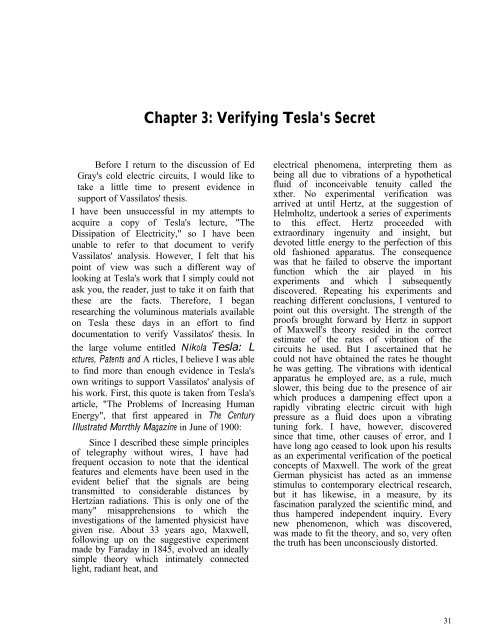Free%20Energy%20Secrets%20with%20Tesla%20patents
Free%20Energy%20Secrets%20with%20Tesla%20patents
Free%20Energy%20Secrets%20with%20Tesla%20patents
You also want an ePaper? Increase the reach of your titles
YUMPU automatically turns print PDFs into web optimized ePapers that Google loves.
Chapter 3: Verifying Tesla's Secret<br />
Before I return to the discussion of Ed<br />
Gray's cold electric circuits, I would like to<br />
take a little time to present evidence in<br />
support of Vassilatos' thesis.<br />
I have been unsuccessful in my attempts to<br />
acquire a copy of Tesla's lecture, "The<br />
Dissipation of Electricity," so I have been<br />
unable to refer to that document to verify<br />
Vassilatos' analysis. However, I felt that his<br />
point of view was such a different way of<br />
looking at Tesla's work that I simply could not<br />
ask you, the reader, just to take it on faith that<br />
these are the facts. Therefore, I began<br />
researching the voluminous materials available<br />
on Tesla these days in an effort to find<br />
documentation to verify Vassilatos' thesis. In<br />
the large volume entitled Nikola Tesla: L<br />
ectures, Patents and A rticles, I believe I was able<br />
to find more than enough evidence in Tesla's<br />
own writings to support Vassilatos' analysis of<br />
his work. First, this quote is taken from Tesla's<br />
article, "The Problems of Increasing Human<br />
Energy", that first appeared in The Century<br />
Illustrated Morrthly Magazine in June of 1900:<br />
Since I described these simple principles<br />
of telegraphy without wires, I have had<br />
frequent occasion to note that the identical<br />
features and elements have been used in the<br />
evident belief that the signals are being<br />
transmitted to considerable distances by<br />
Hertzian radiations. This is only one of the<br />
many" misapprehensions to which the<br />
investigations of the lamented physicist have<br />
given rise. About 33 years ago, Maxwell,<br />
following up on the suggestive experiment<br />
made by Faraday in 1845, evolved an ideally<br />
simple theory which intimately connected<br />
light, radiant heat, and<br />
electrical phenomena, interpreting them as<br />
being all due to vibrations of a hypothetical<br />
fluid of inconceivable tenuity called the<br />
xther. No experimental verification was<br />
arrived at until Hertz, at the suggestion of<br />
Helmholtz, undertook a series of experiments<br />
to this effect. Hertz proceeded with<br />
extraordinary ingenuity and insight, but<br />
devoted little energy to the perfection of this<br />
old fashioned apparatus. The consequence<br />
was that he failed to observe the important<br />
function which the air played in his<br />
experiments and which I subsequently<br />
discovered. Repeating his experiments and<br />
reaching different conclusions, I ventured to<br />
point out this oversight. The strength of the<br />
proofs brought forward by Hertz in support<br />
of Maxwell's theory resided in the correct<br />
estimate of the rates of vibration of the<br />
circuits he used. But I ascertained that he<br />
could not have obtained the rates he thought<br />
he was getting. The vibrations with identical<br />
apparatus he employed are, as a rule, much<br />
slower, this being due to the presence of air<br />
which produces a dampening effect upon a<br />
rapidly vibrating electric circuit with high<br />
pressure as a fluid does upon a vibrating<br />
tuning fork. I have, however, discovered<br />
since that time, other causes of error, and I<br />
have long ago ceased to look upon his results<br />
as an experimental verification of the poetical<br />
concepts of Maxwell. The work of the great<br />
German physicist has acted as an immense<br />
stimulus to contemporary electrical research,<br />
but it has likewise, in a measure, by its<br />
fascination paralyzed the scientific mind, and<br />
thus hampered independent inquiry. Every<br />
new phenomenon, which was discovered,<br />
was made to fit the theory, and so, very often<br />
the truth has been unconsciously distorted.<br />
31












![[Pham_Sherisse]_Frommer's_Southeast_Asia(Book4You)](https://img.yumpu.com/38206466/1/166x260/pham-sherisse-frommers-southeast-asiabook4you.jpg?quality=85)




